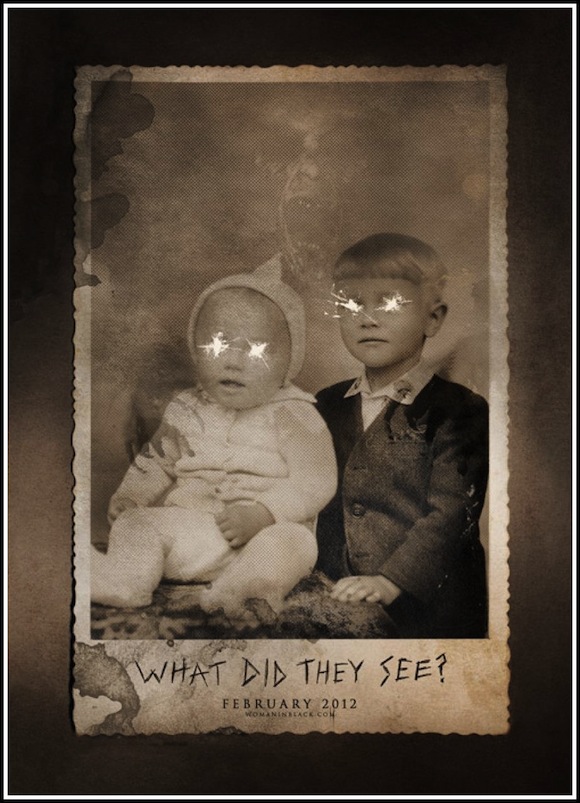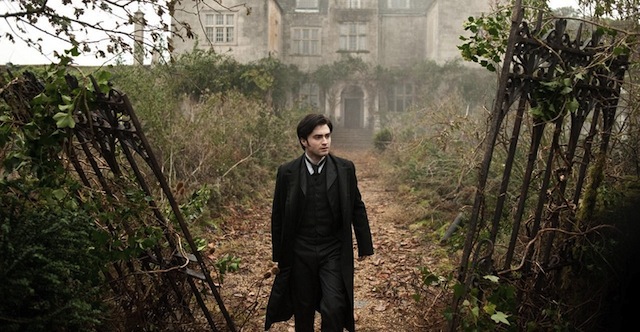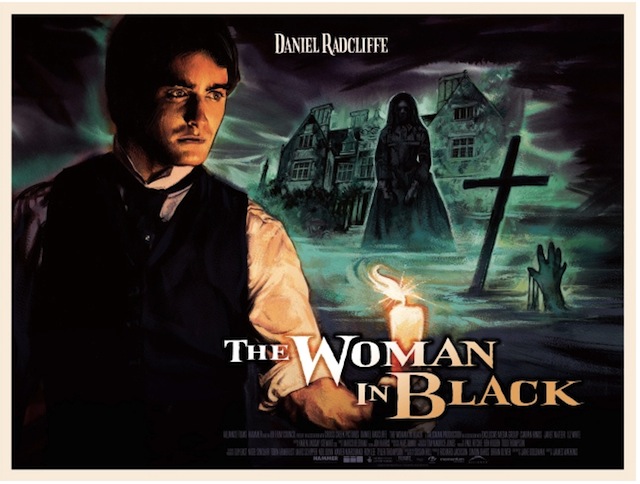Ahoy, squirts! Quint here. My big takeaway after the big word of mouth/press screening of The Woman In Black was gratitude that there was still an audience for a horror movie like this. The Woman In Black isn’t gory, it isn’t gimmicky, it isn’t a rollercoaster ride… it’s an atmospheric old dark house story that relishes in slowly building tension via lighting, geography and performances.
And it worked. Not just critically speaking. The audience yelped, squealed and jumped throughout.

I liked Let Me In (still preferred the original), didn’t care for The Resident, but The Woman In Black is the movie I wanted when I heard Hammer was coming back. It’s fun to see modern filmmaking sensibilities and current actors get to play with these older stylish spook-stories. I loved seeing Daniel Radcliffe dressed to the nines wander around in a thick fog, for instance. In another era that would have been Peter Cushing. Well, Cushing probably would have played the Ciaran Hinds older skeptic part, actually, but you get what I’m saying.
In this old ghost story, Radcliffe plays Arthur Kipps, a depressed young attorney who is trying to keep his life together after the death of his wife. His work is suffering and he’s given one more chance to prove his worth by settling the estate of an old family in a remote English village. Naturally, there’s a supernatural secret being kept in this terrorized little hamlet and Radcliffe slowly uncovers the horrible truth bit by bit.
When I mentioned above that the film smartly uses geography to build tension I was referring to a few things, but one of the neater concepts here is that the old mansion that Radcliffe has to set right is out in the marshlands and the road disappears at every high tide. So, at certain points in the story Radcliffe is literally stuck on this haunted plot of land.
They don’t really use that for a big moment, per se, but there’s just something in us knowing that he’s cut off that makes the tension that much more effective once things start moving in the shadows. Because it’s a period piece you don’t have to explain why he can’t just pick up the phone or dig out his cell phone, which already isolates him, but to further that by literally cutting him off from even just running off this moll serves to put the screws to the audience.
Director James Watkins (Eden Lake) also films the hell out of the house, setting up the geography inside as well. There are two floors, a door that won’t open and seemingly has no key on one end of the hallway and a drape that covers what looks to be almost a black void on the other end. You know some shit is going to go down in this double-FU hallway, it’s just a question of when it’s going to happen.

Watkins uses some jump scares, but for the most part he throws creepy imagery at you over and over again to build tension. He’s aided in this endeavor by the fact that so much of the mythology here surrounds children and at the turn of the century kids had some really fucked up scary toys. Rotted doll faces, maraca playing wind-up monkeys and other such nightmares are constantly shown to us and it’s enough to put even the most manly man on edge. The woman in black and her army of dead children are nothing compared to some of these toys, I’m telling you.
Jane Goldman’s adaptation of Susan Hill’s play doesn’t have much fat on it, which is crucial to a slow-build film. You can’t be both slow and extraneous or you’ve got an audience filled with sleeping people and that does no good to anybody (except insomniacs, I guess). I haven’t seen Hill’s play or the TV movie that came before this one, but I have to imagine the filmmakers opened up the world a bit. You know how sometimes you a see movie and you know instantly it was a play before it was a movie? Usually they take place in one location and you get some stuff at the beginning and at the end where people go outside to show us, “Hey, this isn’t a play, see!”
This one felt pretty organic to me. You get a sense of the village and the devastation this one crazy asshole ghost lady has visited upon its people naturally. It didn’t feel stagebound, that’s for sure.
Not only does the story play with the typical modern haunted house archetypes it also has some fun going on with Ciaran Hinds’ character, a skeptic and sole friendly face for Radcliffe’s Kipps. There’s talk about skepticism and belief in the supernatural that doesn’t overwhelm the actual ghost story going on, but gives us a nicely detailed character, especially in Hinds’ capable hands.
One of my favorite moments of the movie is a small bit between Radcliffe and Hinds, who is dropping the young man at the haunted property. The old skeptic says he’ll return to pick up the young lawyer before the tide comes in and Radcliffe responds that he’s going to stay the night and just finish up the gathering of the paperwork from around the estate. The look on Hinds’ face is brilliant. In a flash the skepticism drops and he believes with every fiber of his being. There’s fear, repulsion at the idea of being alone in that house at night and perhaps a little loathing at himself for being the believer all on his face within a period of about 2 seconds.
What’s the saying? There are no atheists in foxholes? Well, here there are no skeptics at the woman in black’s manor after dark.
It’s the small details like that moment that really made me smile throughout the film. It’s not something that’ll rock you to your core, it’s just plain old good old fashioned spooky storytelling, made all the fresher in this day and age of found footage, rapid editing and technology-driven horror.
More like this, please!

-Eric Vespe
”Quint”
quint@aintitcool.com
Follow Me On Twitter

